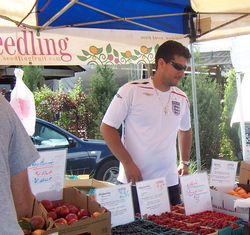Master gardener lesson: Tree fruits and how Michigan growers produce such tasty ones
Michigan grows great tree fruit. I was reminded of this fact this summer when extolling to a Michigan native how much I love cherry season.

Seedling from South Haven at the Westside Farmers Market.
Corinna Borden | Contributor
“The red ones.” I said.
“What variety?”
I looked at him uncomprehendingly. When I grew up in Washington, DC, we would be able to find red cherries for about a week. My mother dealt them out like gold.
So perhaps learning about tree fruit culture in my Master Gardener Volunteer Program will help me become a bit more savvy in the world of bountiful Michigan tree fruits.
According to my reading, Michigan’s growing prowess comes down to the “lake effect,” sandy soils, and good sun. The large bodies of water that surround the mitten moderate the weather patterns throughout the year, reducing the severity of cold spells and lessening the chance of frost injury in the spring. The high elevation of the best fruit-growing regions also makes a difference in the springtime: in areas such as Bainbridge Township, land north of Grand Rapids, Romeo, and much of the Leelanau Peninsula (I immediately think of American Spoon Fruit’s Leelanau Apricot Preserves).
As many of you might know, there is a whole host of insects and diseases that love fruit trees and there seems to be an endless list of fungicides and insecticides that are listed as effective. The variety of pesticides put on trees is one of the many reasons why apples, cherries, nectarines, peaches, and pears are listed in the Dirty Dozen.
The key to success in fruit trees seems to be choosing a variety, or cultivar, that has flower buds able to survive cold temperatures in the wintertime (and resistance to diseases). It is also recommended that you determine whether or not you are going to plant more than one for your home garden. Peach trees will self-pollinate, but apples need more than one within a 2 mile proximity for the bees (crabapple trees may pollinate apples as well). The pollen of fruit trees is heavy and sticky and will not be carried by the wind, unlike corn pollen.
If you are concerned about your fruit being a mix between a McIntosh and a Golden Delicious if you plant two of them close together, never fear! The fruit of a McIntosh tree will yield McIntosh apples; the seeds are a mix between the two. As a result, most fruit trees are grafted because seedlings of trees will vary in their characteristics and the consumer wants a consistent McIntosh (for example). If it is in your back yard, you might be less mindful of such restraints and perform a mini-Mendel pea experiment for your own enjoyment. (Make sure you do not have a lot of dandelions blooming, the bees will go for them and leave your fruit tree alone!)
That is, you can experiment with crossbreeding of fruit trees if you plan to be in that house for a long time. It takes about 3 to 8 years for the tree to establish itself before it will yield fruit. They can be active for up to 60 years.
The grafting of fruit trees is a well-accepted practice in commercial orchards to ensure consistency of fruit. (I will make a small aside here that plant cloning has been going on in our food world for years, and it doesn’t seem to be a big topic of ethical discussion, unlike animal cloning). Another thing that adds to commercial growers' high yields is the practice of thinning. In June growers thin out the immature fruit to ensure consistency of yields from year to year and the health of the final harvest. Commercial fruit growers often use a chemical to thin the fruit - those of you at home can do it by hand.
Here is a great video I found of a nursery in Australia showing the grafting process. I like hearing her voice talk about mango trees in the middle of our winter.
Drop me a line! Check out my website! Read my book! Post a comment and start the conversation rolling!

